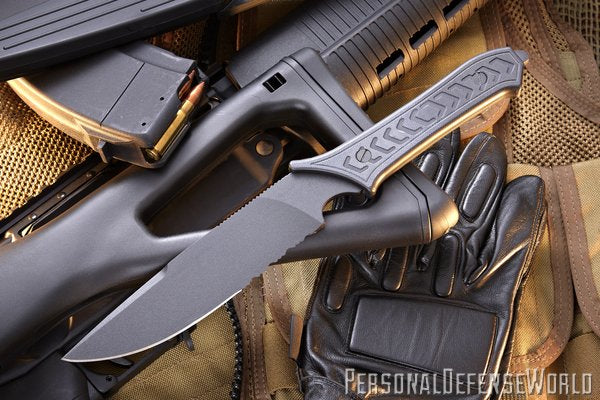BY:TERRILL HOFFMAN
We don’t live in a perfect world. Our military is still in action around the globe, and at home even the average citizen has to consider his or her own personal protection. Crimes that were once limited to the large urban areas have now spread to even remote rural communities. It just isn’t an ideal world. The good news is we have companies such as Mission Knives producing products for the times when things go wrong.
Mission may not be the best-known knife company, but that’s for good reason. They have been supplying edged weapons to our military’s top operators, and they’ve been too busy to sing their own praises. The name is well known to those in the habit of going into harm’s way, but their knives won’t be found in the latest fall hunting catalogs. However, it’s now time for the average citizen to learn what the Navy SEALs have known for a dozen years: Mission knives have a reputation for strength and for enduring the harshest environments around the globe.
I recently requested a sampling of Mission’s product line for review, and they were kind enough to oblige. It would have been easy to say that I wanted to show you, the reader, their knives, but in truth, I wanted to try them myself.
Performance Edge
The knives that arrived constituted a good cross section of the Mission product line. The largest was the MPT-A2 with a 6-inch modified drop-point blade of A2 tool steel. The MPT-A2 was the only knife with handle scales, and they are made of G10 synthetics. Next in size was the MPS-S with a 4.5-inch clip-point blade, also fashioned from A2 tool steel. Further down in size were the MBT-CT, with its 3.5-inch blade, and the MPU, with its 3-inch blade. The MBT-CT has a Tanto-pattern blade, and the knife is made completely of G10. The MPU is titanium and has a spear-point blade pattern. These last three knives are designed to be used cord wrapped or as skeleton blades. After viewing these knives on Mission’s website, I planned to give the larger MPT-A2 a substantial testing. However, I did want to go over a few of the aspects of the other knives.
The smallest knife, the MPU, could be considered sized for concealed carry. The lightweight Titanium construction further enhances the knife for that purpose, and once slipped into your pocket it could go unnoticed until needed. While short in stature, it could prove a formidable weapon in close encounters. The blade is partially serrated and comes with a very acceptable edge. If nothing else, this knife has stirred me to do further research in the future on the use of titanium for knife blades.
If I was unsure about the use of titanium, the G10 construction of the MBT-CT really had me wondering. The 3.5-inch blade has a handle long enough to wrap all four fingers around, but it is still only about one ounce in weight. My first thought was that this knife is a promotional novelty or, at best, a letter opener. Guest what: I was wrong! This knife would make a suitable covert weapon. The blade had an edge capable of causing slicing wounds, and the Tanto design proved stout enough to provide adequate penetration into heavy leather. This knife is a weapon first and foremost, and it isn’t really designed to perform utility duties around a campsite.
The MPS-S is more in line with my thoughts on what a combat knife should be. The A2 steel is razor sharp, and the handle was sized to fit my hand, before and after I applied a cord wrap. The knife was designed as a flat and compact knife purposely intended to fit in the sheath on the military’s current pilot survival vest. Its thin profile and blade length should allow it to excel as a utility and survival knife.
In The Field
I’m a believer in the concept of “bigger is better.” The MPT-A2 was the largest knife of the four and the one I wanted to test as an example of Mission’s quality level. The 6-inch drop point has a false edge along the blade’s first 2.88 inches and is partially serrated. The G10 handle scales slope up toward the blade to form a thumb ramp, but since the handle is slightly below the spine of the blade, the ramp does not interfere with the hand when it’s choked up for more delicate work. The knife also features a large finger choil for the same purpose. The tang is totally covered by the G10 scales, but protrudes 0.25 inches at the butt of the knife. The blade has a thickness of 0.17 inches and a depth of 1.37 inches, giving the knife a neutral balance at the beginning of the handle. The knife is supplied with a molded synthetic sheath with a Nylon belt loop and retention strap. The sheath’s low-ride feature is comfortable, but it really isn’t compatible with concealed carry. Fortunately, I live I a rural area, where few would even notice a person wearing a knife on his belt. Despite its overall length of 11 inches, the knife was easy to work with, and I was able to use it for several mundane chores on a daily basis. More than once, dinner guests had to tolerate the fact that I had the sharpest steak knife at the table.
The MPT-A2 is designed to be a combat knife, but it proved itself as a utility tool. The only time I had a problem with the knife was as a result of the partially serrated blade. As I was sharpening wooden stakes for the lay out of a new tractor shed, I discovered that the serrations are ground in the wrong direction for left-handed use. Fortunately, the knife can be ordered with or without the serrations.
The MPT-A2’s blade is longer than that on my personal hunting knife, but it proved to be a good substitute during deer season. It took me a few minutes to get used to the extra length while skinning, but the whole process became second nature by the time I finished the second animal. Cutting steaks and skinning deer may not seem like a good use of a combat knife, but it does serve a useful purpose. Using a knife on a daily basis helps develop the level of confidence required for employing the knife as a defensive weapon—though, as with any weapon, you should practice specific defensive skills whenever possible. As such, the MPT-A2 became my constant companion at my rifle range. Every time I practiced with my firearms, I would also put in defensive practice with the knife. I am not a knife-fighting expert, and my grace with an edged weapon may be somewhat lacking. However, I do realize that stabbing and slicing with a knife aren’t movements that come naturally. To put a tactical knife into use, you need to move into your opponent. It’s just the opposite of how one handles a handgun, proving that with each weapon there’s a different skill set that needs to be reinforced with practice.
Besides using a training dummy, I also practiced my defensive knife technique on the carcasses of the many deer taken during the season. The Mission knife proved itself more than capable of inflicting serious injury. Only the ribs of the deer controlled slicing cuts, and the full length of the blade would penetrate with thrusting movements. To some this may seem excessive, but you should know what to expect if you are going to use a knife as a weapon.
The MPT-A2, like all of Mission’s knives, are 100-percent made in the United States. It also showed why Mission has gained a reputation for quality. I was able to handle four of the Mission knives, but they make others. I would suggest you review their entire product line and choose the one that best fits your needs. Personally, I think a combination of a small covert blade with a full-sized combat knife is ideal.
For the complete article please refer to Tactical Knives July 2013.







